Retail behemoth Walmart (NYSE:WMT) beat analysts' expectations in Q4 FY2024, with revenue up 5.7% year on year to $173.4 billion. It made a non-GAAP profit of $1.80 per share, improving from its profit of $1.71 per share in the same quarter last year.
Walmart (WMT) Q4 FY2024 Highlights:
- Revenue: $173.4 billion vs analyst estimates of $169.3 billion (2.4% beat)
- EPS (non-GAAP): $1.80 vs analyst estimates of $1.65 (9.4% beat)
- EPS (non-GAAP) Guidance for Q1 2025 is $1.52 at the midpoint, below analyst estimates of $1.60
- Free Cash Flow of $10.78 billion, up 29.1% from the same quarter last year
- Gross Margin (GAAP): 24%, up from 23.5% in the same quarter last year
- Same-Store Sales were up 4% year on year
- Number of Stores: ~10,500
- Market Capitalization: $458.6 billion
Known for its large-format Supercenters, Walmart (NYSE:WMT) is a retail pioneer that serves a budget-conscious consumer who is looking for a wide range of products under one roof.
Founded in 1962 by Sam Walton in Bentonville, Arkansas, Walmart is currently one of the world's largest retailers. The company is known for its "Everyday Low Prices" strategy, which is achieved through bulk purchasing, cost efficiency, and optimizing supply chain management.
Walmart serves the value-focused household in suburban and rural areas by offering low prices and convenience. Convenience from the core Supercenter concept stems from offering everything from groceries to clothing to toys to home décor to consumer electronics under one roof. Recent initiatives to add convenience to the Walmart shopping experience include launching the ecommerce site in 2000, online grocery order and physical pickup in 2014, and grocery delivery in 2018.
While the Walmart Supercenter—which can be 200,000 square feet per store—is the most famous format, the company also has smaller formats and other banners such as the Sam’s Club membership warehouse concept. For example, the company launched Walmart Neighborhood Markets in 1998. These stores were meant for more dense urban areas where a large format store would not be feasible, and the limited space was dedicated primarily to groceries and pharmacy services.
Large-format Grocery & General Merchandise Retailer
Big-box retailers operate large stores that sell groceries and general merchandise at highly competitive prices. Because of their scale and resulting purchasing power, these big-box retailers–with annual sales in the tens to hundreds of billions of dollars–are able to get attractive volume discounts and sell at often the lowest prices. While e-commerce is a threat, these retailers have been able to weather the storm by either providing a unique in-store shopping experience or by reinvesting their hefty profits into omnichannel investments.
Scaled competitors that sell general merchandise and/or groceries to US consumers include Amazon.com (NASDAQ:AMZN), Costco (NYSE:COST), and Dollar General (NYSE:DG).Sales Growth
Walmart is a behemoth in the consumer retail sector and benefits from economies of scale, an important advantage giving the business an edge in distribution and more negotiating power with suppliers.
As you can see below, the company's annualized revenue growth rate of 5.5% over the last four years (we compare to 2019 to normalize for COVID-19 impacts) was weak as its store count was flat, signaling that growth was driven by more sales at existing, established stores.
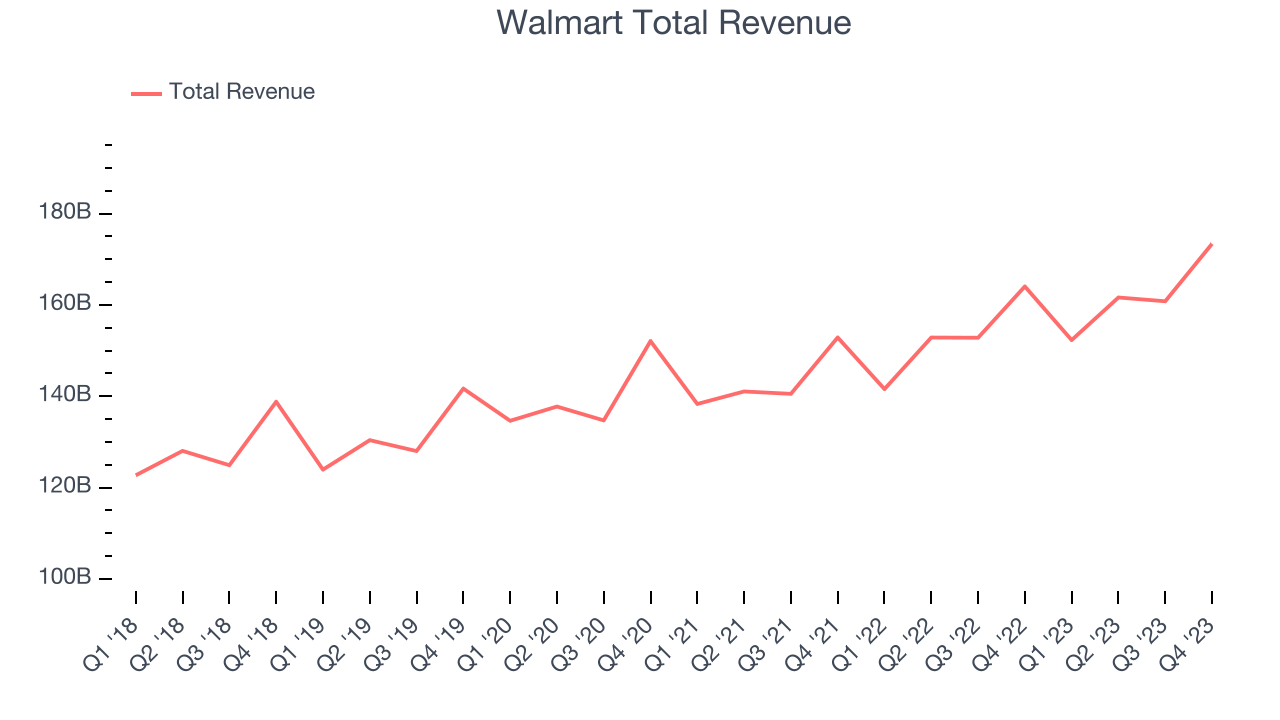
This quarter, Walmart reported solid year-on-year revenue growth of 5.7%, and its $173.4 billion in revenue outperformed Wall Street's estimates by 2.4%. Looking ahead, Wall Street expects sales to grow 2.2% over the next 12 months, a deceleration from this quarter.
Same-Store Sales
Same-store sales growth is a key performance indicator used to measure organic growth and demand for retailers.
Walmart's demand within its existing stores has generally risen over the last two years but lagged behind the broader consumer retail sector. On average, the company's same-store sales have grown by 6.3% year on year. Given its flat store count over the same period, this performance stems from higher e-commerce sales or increased foot traffic at existing stores.
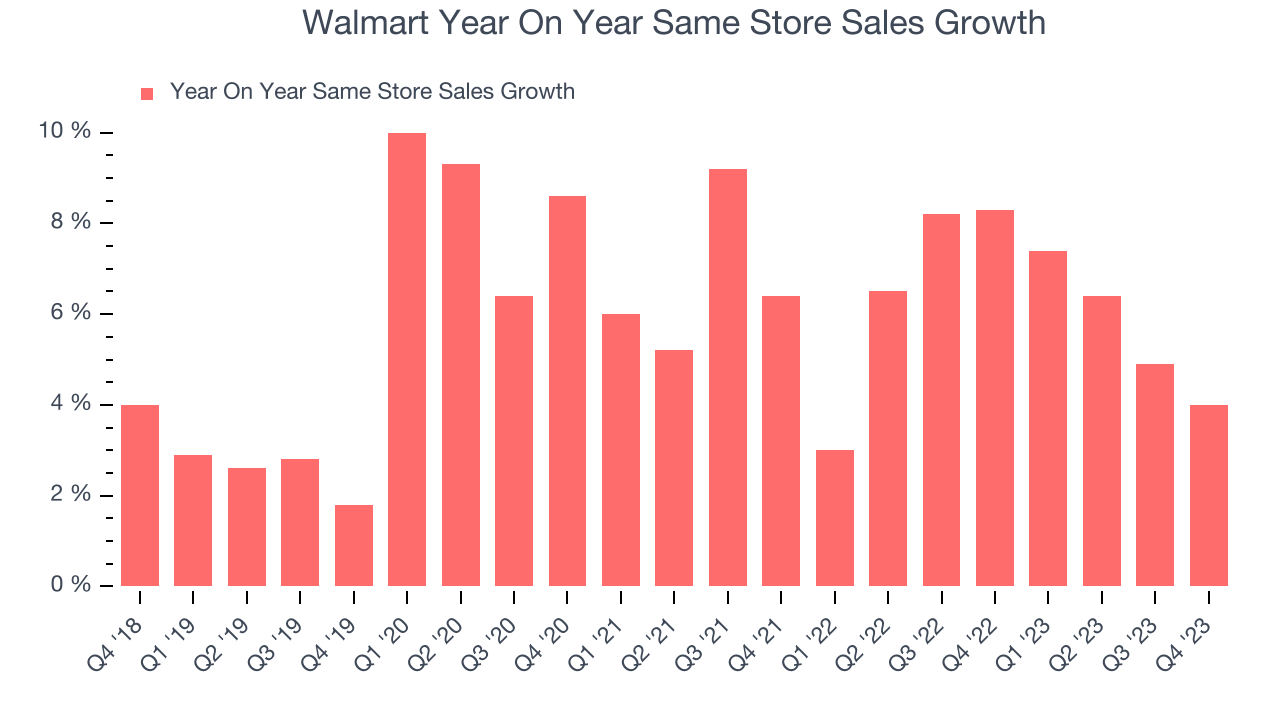
In the latest quarter, Walmart's same-store sales rose 4% year on year. By the company's standards, this growth was a meaningful deceleration from the 8.8% year-on-year increase it posted 12 months ago. We'll be watching Walmart closely to see if it can reaccelerate growth.
Gross Margin & Pricing Power
Gross profit margins tell us how much money a retailer gets to keep after paying for the goods it sells.
Walmart has poor unit economics for a retailer, leaving it with little room for error if things go awry. As you can see below, it's averaged a 24.3% gross margin over the last two years. However, when comparing its margin specifically to other non-discretionary retailers, it's actually pretty decent. That's because non-discretionary retailers have structurally lower gross margins as they compete to provide the lowest possible price, sell products easily found elsewhere, and have high transportation costs to move their goods. We believe the best metrics to assess these types of companies are free cash flow margin, operating leverage, and profit volatility, which take their scale advantages and non-cyclical demand characteristics into account. 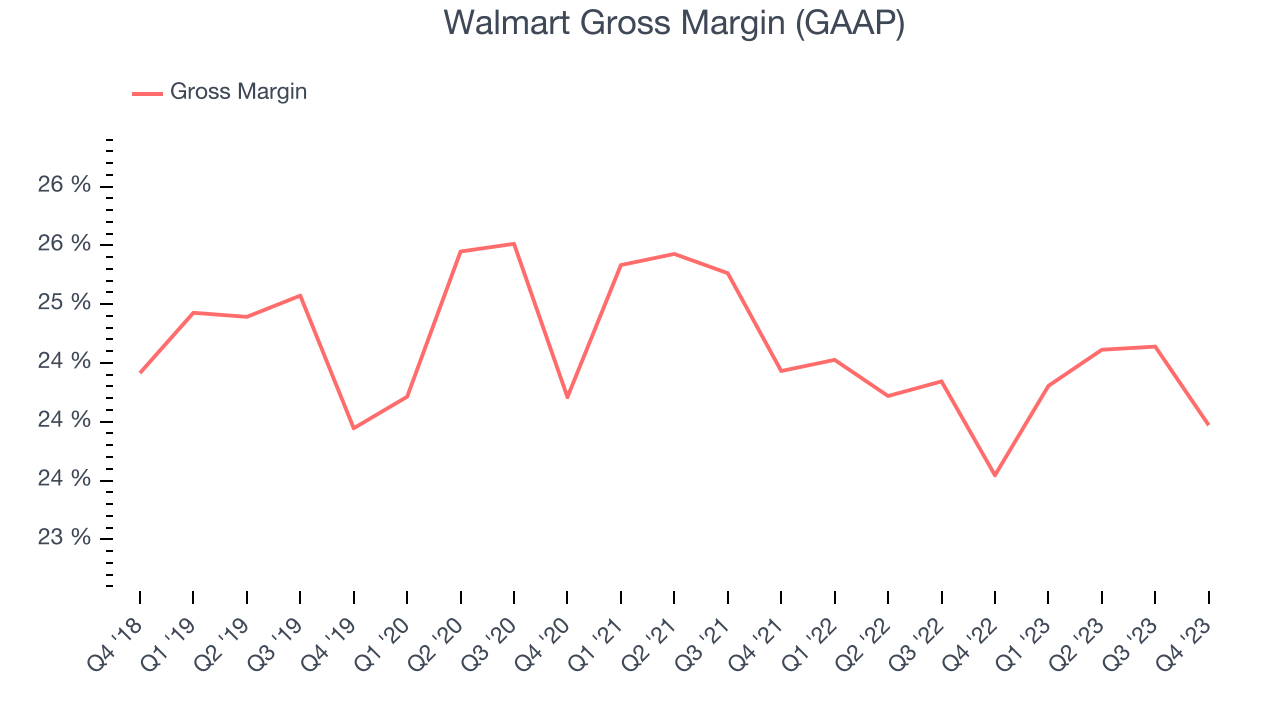
Walmart produced a 24% gross profit margin in Q4, flat with the same quarter last year. This steady margin for a retailer like Walmart, which is structurally less profitable than the typical retail business for the reasons mentioned above, signals that it has stable input costs (such as freight expenses to transport goods) and aims to keep prices low for consumers.
Operating Margin
Operating margin is a key profitability metric for retailers because it accounts for all expenses keeping the lights on, including wages, rent, advertising, and other administrative costs.
This quarter, Walmart generated an operating profit margin of 4.2%, in line with the same quarter last year. This indicates the company's costs have been relatively stable.
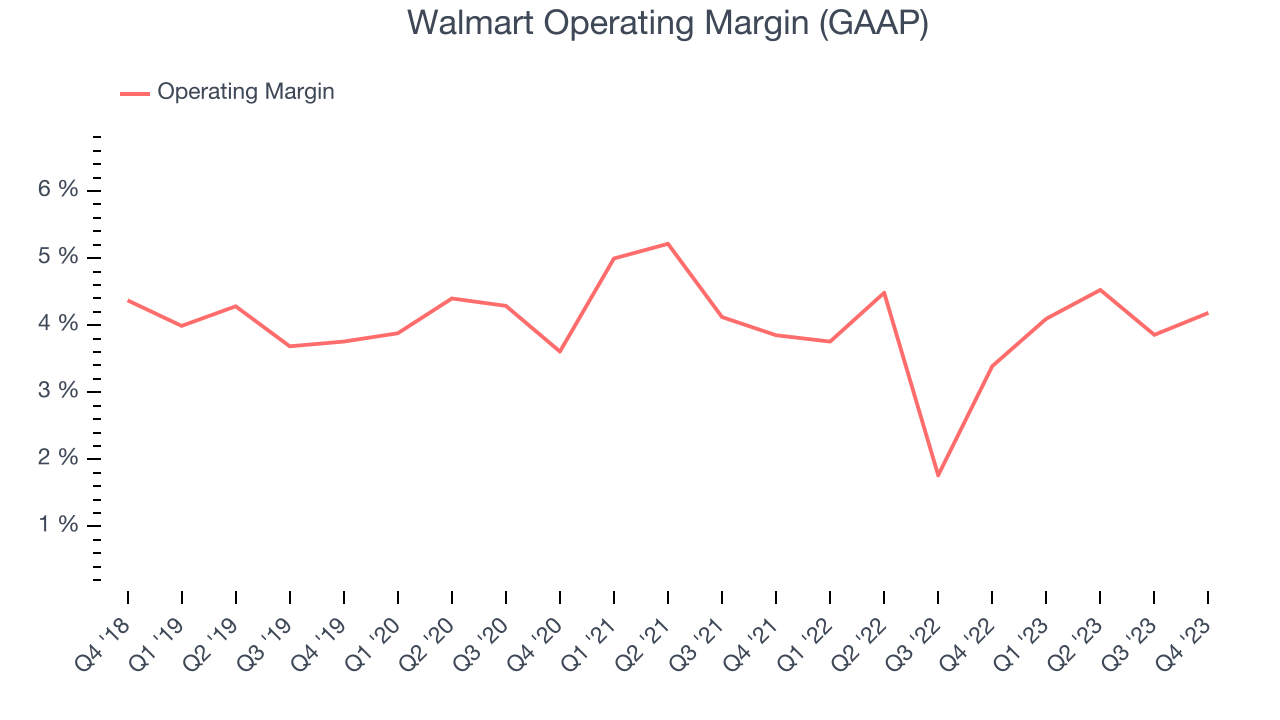 Zooming out, Walmart was profitable over the last two years but held back by its large expense base. Its average operating margin of 3.8% has been paltry for a consumer retail business. Its margin has also seen few fluctuations, meaning it will take a big change to improve profitability.
Zooming out, Walmart was profitable over the last two years but held back by its large expense base. Its average operating margin of 3.8% has been paltry for a consumer retail business. Its margin has also seen few fluctuations, meaning it will take a big change to improve profitability.EPS
Earnings growth is a critical metric to track, but for long-term shareholders, earnings per share (EPS) is more telling because it accounts for dilution and share repurchases.
In Q4, Walmart reported EPS at $1.80, up from $1.71 in the same quarter a year ago. This print beat Wall Street's estimates by 9.4%.
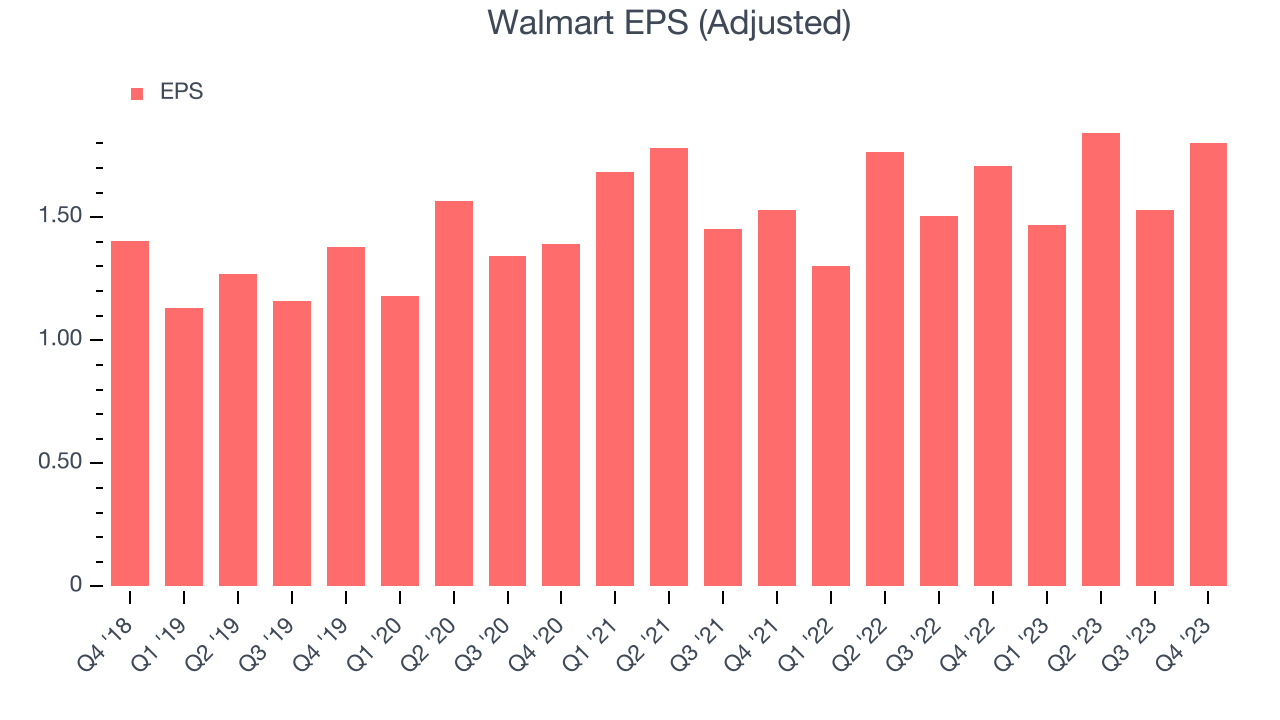
Between FY2020 and FY2024, Walmart's adjusted diluted EPS grew 34.4%, translating into an unimpressive 7.7% compounded annual growth rate.
On the bright side, Wall Street expects the company to continue growing earnings over the next 12 months, with analysts projecting an average 5.8% year-on-year increase in EPS.
Cash Is King
Although earnings are undoubtedly valuable for assessing company performance, we believe cash is king because you can't use accounting profits to pay the bills.
Walmart's free cash flow came in at $10.78 billion in Q4, up 29.1% year on year. This result represents a 6.2% margin.
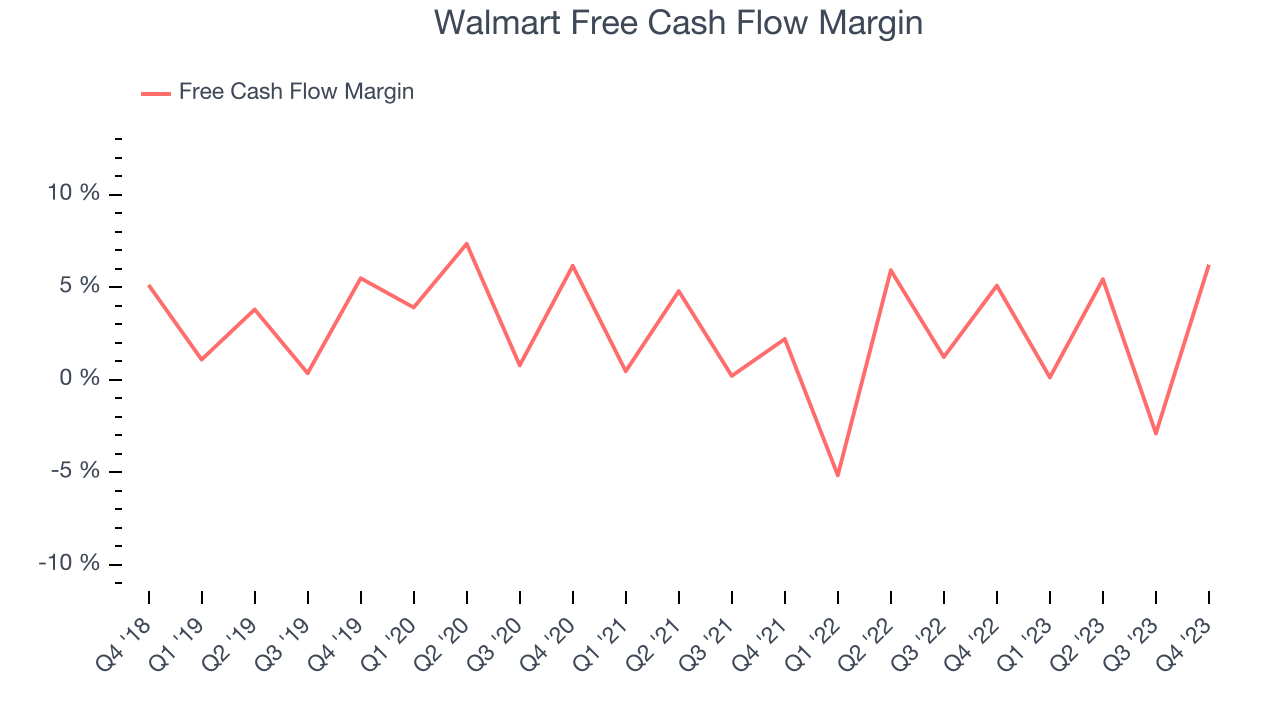
Over the last two years, Walmart has shown decent cash profitability, giving it some reinvestment opportunities. The company's free cash flow margin has averaged 2.2%, slightly better than the broader consumer retail sector. Furthermore, its margin has been flat, showing that the company's cash flows are relatively stable.
Return on Invested Capital (ROIC)
EPS and free cash flow tell us whether a company was profitable while growing revenue. But was it capital-efficient? A company’s ROIC explains this by showing how much operating profit a company makes compared to how much money the business raised (debt and equity).
Walmart's five-year average ROIC was 15.6%, slightly better than the broader sector. Just as you’d like your investment dollars to generate returns, Walmart's invested capital has produced decent profits.
The trend in its ROIC, however, is often what surprises the market and drives the stock price. Over the last two years, Walmart's ROIC averaged a 2 percentage point increase each year. This is a good sign, and if the company's returns keep rising, there's a chance it could evolve into an investable business.
Key Takeaways from Walmart's Q4 Results
We enjoyed seeing Walmart exceed analysts' revenue, gross margin, and EPS expectations this quarter. That performance was driven by beats in its U.S. and International Walmart operations. On the other hand, Walmart's Sam's Club division lagged Wall Street's projections, and its earnings forecast for the full year 2024 missed analysts' expectations. The company also bought TV maker Vizio for just over $2 billion in February to support Walmart Connect, its media business. Zooming out, we think the company had a decent quarter, but its guidance was underwhelming. The stock is up 2% after reporting and currently trades at $173.84 per share.
Is Now The Time?
Walmart may have had a favorable quarter, but investors should also consider its valuation and business qualities when assessing the investment opportunity.
Walmart isn't a bad business, but it probably wouldn't be one of our picks. Its revenue growth has been a little slower over the last four years, and analysts expect growth to deteriorate from here. And while its coveted brand awareness makes it a household name consumers consistently turn to, the downside is its gross margins make it more challenging to reach positive operating profits compared to other consumer retail businesses. On top of that, its operating margins reveal poor profitability compared to other retailers.
Walmart's price-to-earnings ratio based on the next 12 months is 24.2x. We can find things to like about Walmart and there's no doubt it's a bit of a market darling, at least for some investors. But it seems there's a lot of optimism already priced in and we wonder if there are better opportunities elsewhere right now.
Wall Street analysts covering the company had a one-year price target of $181.66 per share right before these results (compared to the current share price of $173.84).
To get the best start with StockStory, check out our most recent stock picks, and then sign up to our earnings alerts by adding companies to your watchlist here. We typically have the quarterly earnings results analyzed within seconds of the data being released, and especially for companies reporting pre-market, this often gives investors the chance to react to the results before the market has fully absorbed the information.
